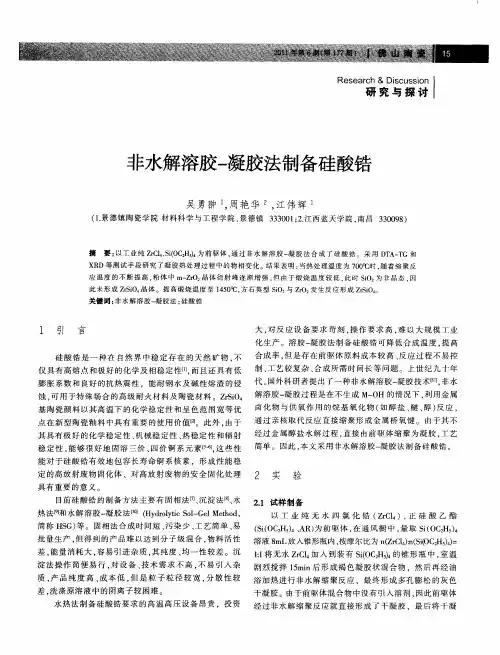硅酸锆粉体的合成研究
- 格式:pdf
- 大小:1.77 MB
- 文档页数:5
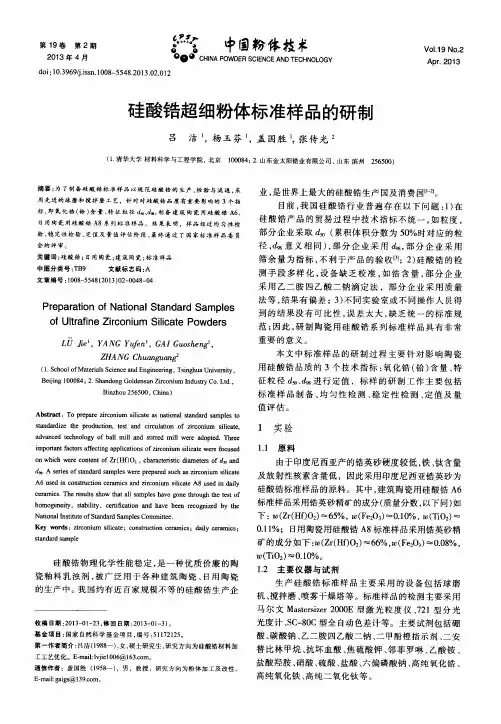
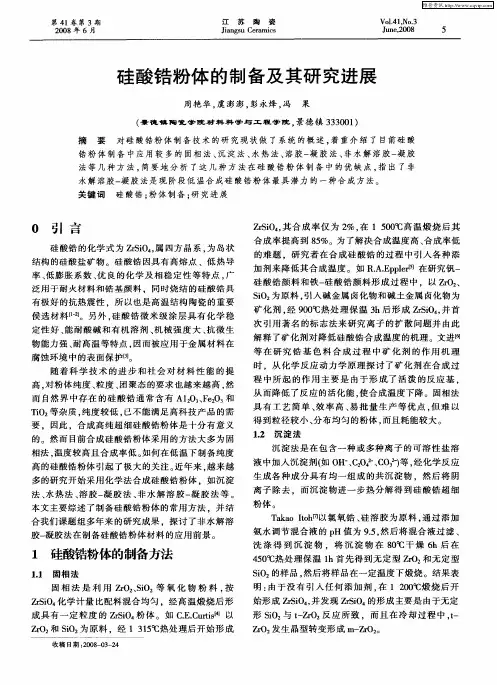

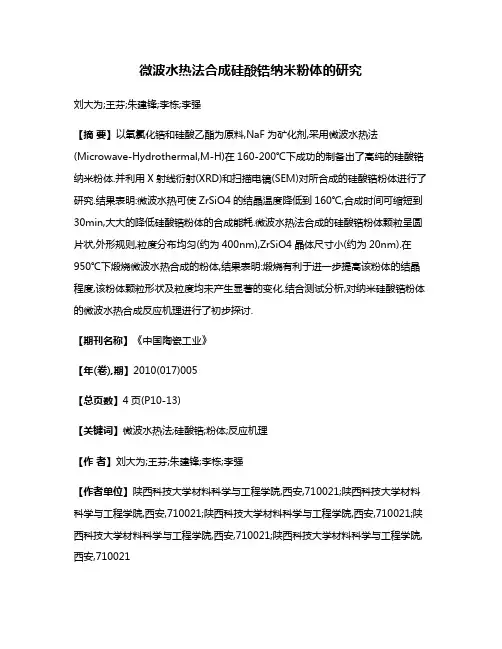
微波水热法合成硅酸锆纳米粉体的研究刘大为;王芬;朱建锋;李栋;李强【摘要】以氧氯化锆和硅酸乙酯为原料,NaF为矿化剂,采用微波水热法(Microwave-Hydrothermal,M-H)在160-200℃下成功的制备出了高纯的硅酸锆纳米粉体.并利用X射线衍射(XRD)和扫描电镜(SEM)对所合成的硅酸锆粉体进行了研究.结果表明:微波水热可使ZrSiO4的结晶温度降低到160℃,合成时间可缩短到30min,大大的降低硅酸锆粉体的合成能耗.微波水热法合成的硅酸锆粉体颗粒呈圆片状,外形规则,粒度分布均匀(约为400nm),ZrSiO4晶体尺寸小(约为20nm).在950℃下煅烧微波水热合成的粉体,结果表明:煅烧有利于进一步提高该粉体的结晶程度,该粉体颗粒形状及粒度均未产生显著的变化.结合测试分析,对纳米硅酸锆粉体的微波水热合成反应机理进行了初步探讨.【期刊名称】《中国陶瓷工业》【年(卷),期】2010(017)005【总页数】4页(P10-13)【关键词】微波水热法;硅酸锆;粉体;反应机理【作者】刘大为;王芬;朱建锋;李栋;李强【作者单位】陕西科技大学材料科学与工程学院,西安,710021;陕西科技大学材料科学与工程学院,西安,710021;陕西科技大学材料科学与工程学院,西安,710021;陕西科技大学材料科学与工程学院,西安,710021;陕西科技大学材料科学与工程学院,西安,710021【正文语种】中文【中图分类】TQ175.751 前言硅酸锆(ZrSiO4)属四方晶系,具有优良的化学及相稳定性、高熔点、高热传导率和抗热震性以及良好的离子掺杂性,使其具有广泛的应用前景。
如硅酸锆基陶瓷颜料具有高温化学稳定性和呈色范围宽等优点,在新型陶瓷釉料中具有重要的使用价值[2-3]。
近年来,发展起来的微米级硅酸锆涂层具有化学稳定性好,耐高温、酸碱和有机溶剂的腐蚀,机械强度大,抗微生物能力强等特点,广泛应用于腐蚀环境中金属材料以及其它材料的表面保护。
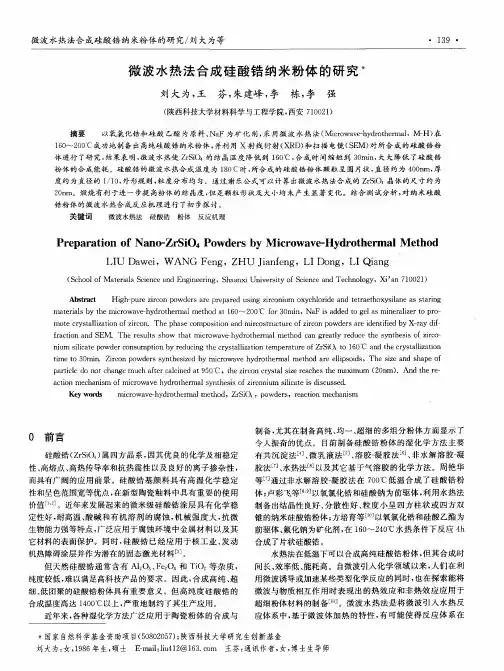
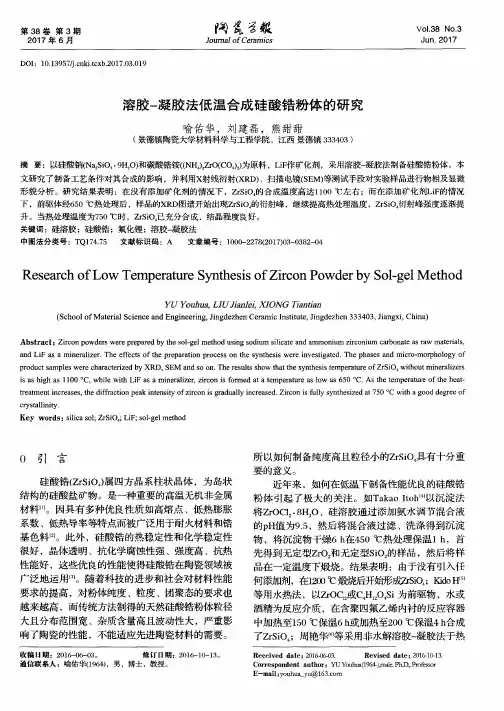
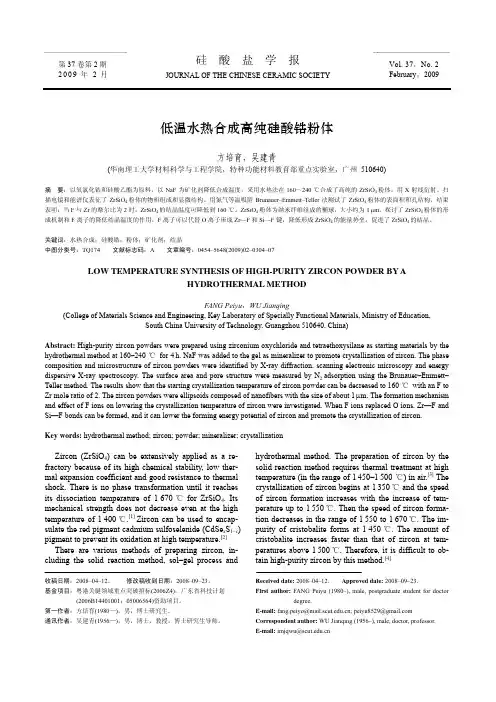
硅酸盐学报· 304 ·2009年低温水热合成高纯硅酸锆粉体方培育,吴建青(华南理工大学材料科学与工程学院,特种功能材料教育部重点实验室,广州 510640)摘要:以氧氯化锆和硅酸乙酯为原料,以NaF为矿化剂降低合成温度,采用水热法在160~240℃合成了高纯的ZrSiO4粉体。
用X射线衍射、扫描电镜和能谱仪表征了ZrSiO4粉体的物相组成和显微结构。
用氮气等温吸附Brunauer–Emmett–Teller法测试了ZrSiO4粉体的表面积和孔结构。
结果表明:当F与Zr的摩尔比为2时,ZrSiO4的结晶温度可降低到160℃。
ZrSiO4粉体为纳米纤维组成的椭球,大小约为1μm。
探讨了ZrSiO4粉体的形成机制和F离子的降低结晶温度的作用,F离子可以代替O离子形成Zr—F和Si—F键,降低形成ZrSiO4的能量势垒,促进了ZrSiO4的结晶。
关键词:水热合成;硅酸锆;粉体;矿化剂;结晶中图分类号:TQ174 文献标志码:A 文章编号:0454–5648(2009)02–0304–07LOW TEMPERATURE SYNTHESIS OF HIGH-PURITY ZIRCON POWDER BY AHYDROTHERMAL METHODF ANG Peiyu,WU Jianqing(College of Materials Science and Engineering, Key Laboratory of Specially Functional Materials, Ministry of Education,South China University of Technology, Guangzhou 510640, China)Abstract: High-purity zircon powders were prepared using zirconium oxychloride and tetraethoxysilane as starting materials by the hydrothermal method at 160–240℃ for 4h. NaF was added to the gel as mineralizer to promote crystallization of zircon. The phase composition and microstructure of zircon powders were identified by X-ray diffraction, scanning electronic microscopy and energy dispersive X-ray spectroscopy. The surface area and pore structure were measured by N2 adsorption using the Brunauer–Emmett– Teller method. The results show that the starting crystallization temperature of zircon powder can be decreased to 160℃with an F to Zr mole ratio of 2. The zircon powders were ellipsoids composed of nanofibers with the size of about 1μm. The formation mechanism and effect of F ions on lowering the crystallization temperature of zircon were investigated. When F ions replaced O ions, Zr—F and Si—F bonds can be formed, and it can lower the forming energy potential of zircon and promote the crystallization of zircon.Key words: hydrothermal method; zircon; powder; mineralizer; crystallizationZircon (ZrSiO4) can be extensively applied as a re-fractory because of its high chemical stability, low ther-mal expansion coefficient and good resistance to thermal shock. There is no phase transformation until it reaches its dissociation temperature of 1670℃ for ZrSiO4. Its mechanical strength does not decrease even at the high temperature of 1400.℃[1] Zircon can be used to encap-sulate the red pigment cadmium sulfoselenide (CdSe x S1–x) pigment to prevent its oxidation at high temperature.[2] There are various methods of preparing zircon, in-cluding the solid reaction method, sol–gel process and hydrothermal method. The preparation of zircon by the solid reaction method requires thermal treatment at high temperature (in the range of 1450–1500℃) in air.[3] The crystallization of zircon begins at 1350℃ and the speed of zircon formation increases with the increase of tem-perature up to 1550.℃Then the speed of zircon forma-tion decreases in the range of 1550 to 1670. The i℃m-purity of cristobalite forms at 1450. The amount of℃cristobalite increases faster than that of zircon at tem-peratures above 1500.℃Therefore, it is difficult to ob-tain high-purity zircon by this method.[4]收稿日期:2008–04–12。
